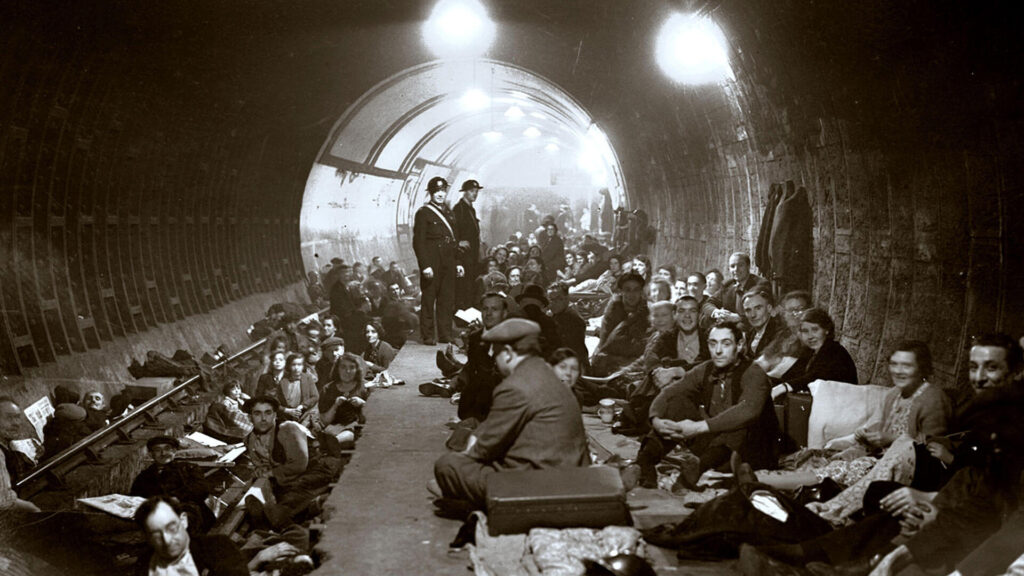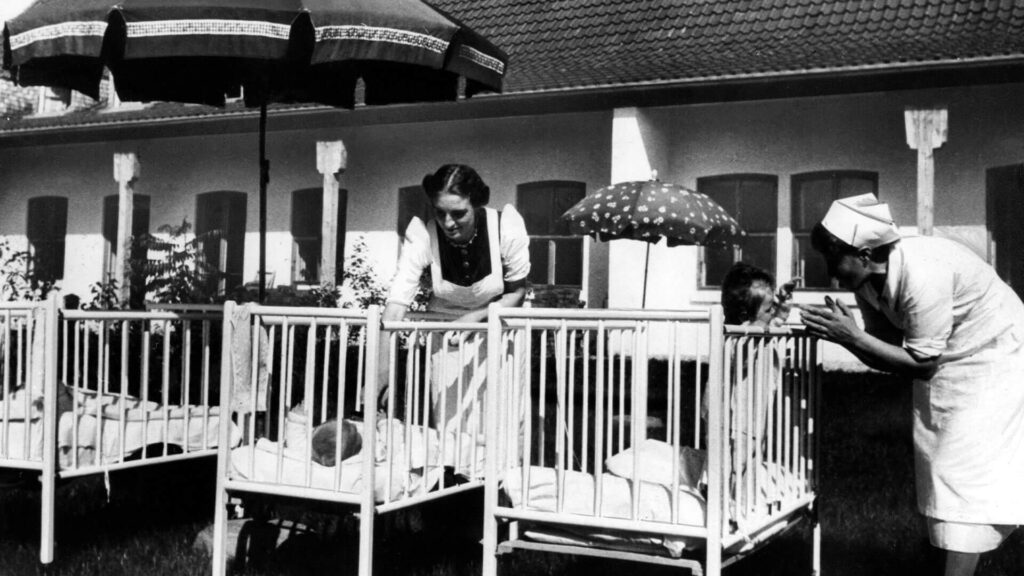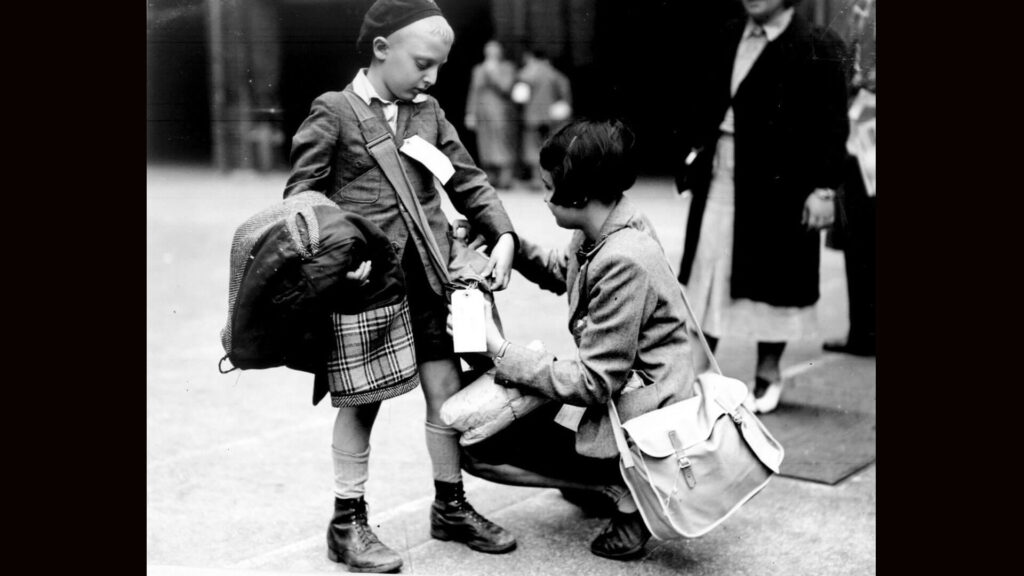Episode 1: History & Images
Dig deeper into the real-life events of WW2 that are addressed in Episode 1 of World on Fire, from refugees’ assimilation in Britain to the Nazi SS’s eugenics efforts. How did the British home front unite during the Blitz? What were Hitler Youth girls doing to serve their Führer? Learn more right here and then look for our History & Images features after every episode of World on Fire Season 2.
- 1.
British Home Front During the Blitz


Seeking shelter from aerial bombing in the London underground, 1940 World on Fire Episode 1 opens in Manchester, England in October 1940 as sirens warn German planes are in the skies above. The eight-month-long Blitz was a time of great destruction and death across major British cities: London alone was bombed for 57 consecutive nights (BBC), 1.1 million homes were damaged or destroyed (Britannica), 180,000 people sheltered in the underground each evening (The Daily Mail UK), and some 40,000 civilians died (UK Parliament).
While British authorities hoped maintaining calm would define its citizens, people’s “understandable reaction was fear. Endurance was unavoidable, and survival their chief priority,” says historian Richard Overy in The Guardian (UK). Women and children evacuated bigger cities. Trenches were dug, public buildings were stabilized with sandbags, and civilians trained for duties like firefighting, first aid, and ambulance driving. People learned how to use gas masks. At night, a rigorous policy of blackout began and by day, folks tried to get on with life.
Women rallied to an extraordinary degree during the Blitz, addressing the daily challenge of rationing, recycling, reusing, and growing crops in garden allotments. In devastated cities, one in 10 females joined the Women’s Voluntary Service according to The Guardian, doing “whatever was needed,” from feeding and sheltering the newly homeless, running clothing centers and mobile canteens, to working in medical clinics. And women filled the formerly male-dominated roles of mechanics, engineers, air raid wardens, and fire engine and ambulance drivers.
The mass public hysteria Hitler predicted never occurred. Listen to four British civilians talk about the London Blitz in an oral history recording housed at the Imperial War Museum in London.
- 2.
Nazi’s Lebensborn program


A Lebensborn maternity home, 1940 Early in Episode 1, young Berliner Marga sings with her uniformed comrades in the League of German Girls. This voluntary group was the Hitler Youth movement’s female wing and members were sometimes recruited for the nation’s Lebensborn program, meant to reverse Germany’s diminishing birthrate.
Lebensborn, meaning “Fount of Life,” was developed by the Nazi SS. Its attempt to produce “racially pure” blonde-haired, blue-eyed children had a few different approaches. First, “racially elite” SS men and Wehrmacht officers were encouraged to expand their families to at least four children.
The SS effort then recruited pregnant, unmarried “Aryan” women. “The program offered mothers financial support and adoption services,” according to the United States Holocaust Memorial Museum. “It also provided a series of private maternity homes away from judgmental eyes.” And then there were young girls like Marga, proud to serve Germany by traveling to Lebensborn homes to meet and have sex with SS officers. If children were conceived, they were usually taken at birth by the SS. Of all the young women who applied, “only 40 percent passed the racial purity test and were granted admission to the Lebensborn program,” according to the Jewish Virtual Library.
The program went to further extremes as German war casualties grew, establishing Lebensborn homes in Nazi-occupied territories and encouraging troops to impregnate “appropriate” foreigners. There were “nine [of these homes] in Norway, two in Austria, and one each in Belgium, Holland, France, Luxembourg and Denmark,” as researched by the Jewish Virtual Library. Lebensborn also resorted to kidnapping thousands of “biologically valuable” foreign children to be raised in German homes. The Warfare History Network estimates “approximately 200,000 Polish children were stolen by the Nazis between 1939 and 1944.”
Read the contents of a Lebensborn brochure from WW2.
- 3.
Refugee Experience in England


Polish refugees in London, 1939 In Episode 1, all three Tomaszeski siblings reunite in a British tearoom, but their gathering sours when a local insults them. Germany’s invasion of Western Europe produced waves of refugees seeking asylum from political and ethnic or religious persecution. Some 160,000 Poles alone arrived in Britain right after their country was invaded, according to the BBC.
It’s generally assumed the Poles were warmly accepted by the British, according to The National Archives (UK), when in fact they got a range of reactions—from sympathy to ambivalence and outright hostility. Less than welcoming receptions may have been due to England’s significant food shortages, perceptions the newcomers were on Britain’s dole, and attitudes about their not speaking the local language. It seems wartime allies are not necessarily friends.
And it was typical for refugees to struggle feeling at home in the UK. Most arrived after experiencing significant trauma and then had to grapple with a new language and culture while still reeling from their own losses of country, family, and vocation. It’s important to realize, then, that many men who fled Poland heroically served in the Allied armed forces. And that those Jewish Poles “granted entry [to Britain] were admitted only because the Jewish community guaranteed it would bear all the expenses of accommodation and maintenance, with no burden placed on the public purse,” according to The Guardian (UK).




















